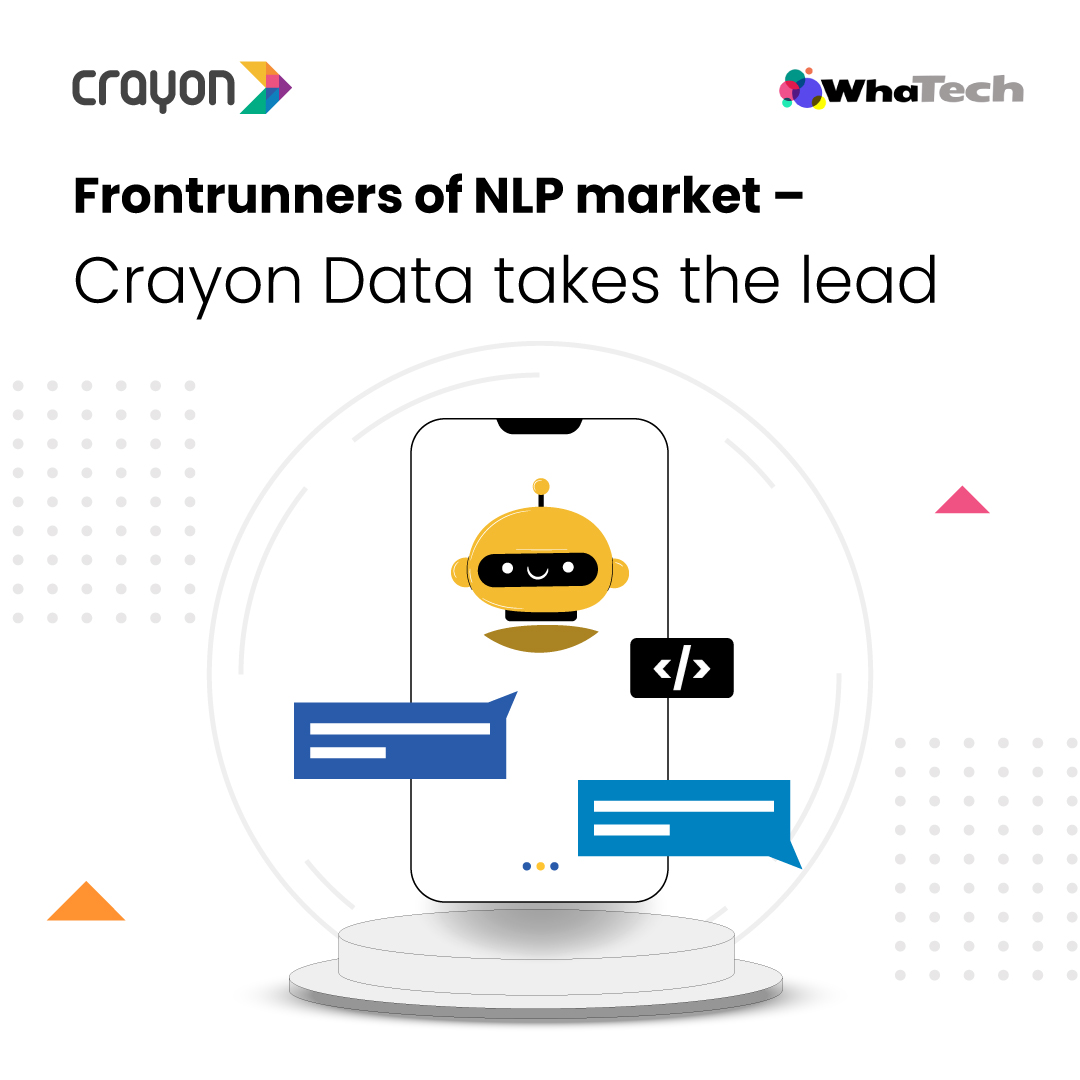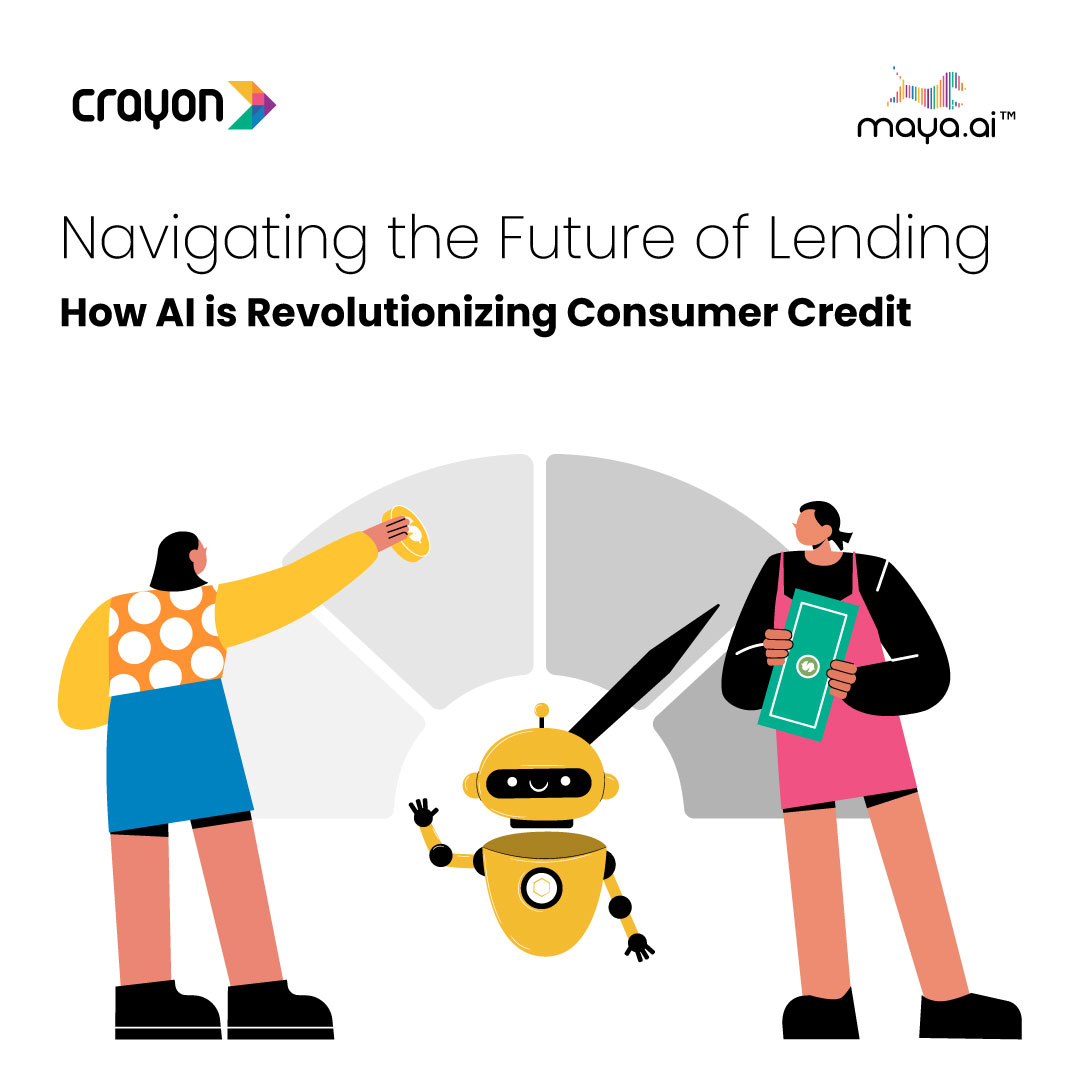
Legends of AI: Herbert Simon
February 16, 2024
Karunakaran Neelakandan on Indian Startup Times’ list of visionaries at the helm of Artificial Intelligence
April 1, 2024The Crayon Blog
Natural Language Processing Market Propelled by Rising Adoption of Chatbots and Need for Efficient Data Processing
| Published March 22, 2023 | The Crayon Team
In this age of AI, NLP (Natural Language Processing) is one of the most-sought after capabilities by enterprises. With their to ability to efficiently analyze unstructured data, their popularity is not just a trend, but is here to stay for good and evolve further.
We at Crayon Data have been pioneers in using NLP on external data and combining it with enterprise data to unlock value for enterprises. So it’s only natural that we aced this game! Here is WhaTech’s take on the exponentially expanding market of NLP and Crayon Data’s position in this field.
Increasing demand for conversational AI and text analysis drives growth in the Natural Language Processing Market.
We at Crayon Data have been pioneers in using NLP on external data and combining it with enterprise data to unlock value for enterprises. So it’s only natural that we aced this game! Here is WhaTech’s take on the exponentially expanding market of NLP and Crayon Data’s position in this field.
Increasing demand for conversational AI and text analysis drives growth in the Natural Language Processing Market.
Natural Language Processing Market Scope and Overview
Natural Language Processing Market size was valued at USD 29.1 billion in 2022 and is expected to grow to USD 415.4 billion by 2030 and grow at a CAGR of 39.42 % over the forecast period of 2023-2030.
Natural Language Processing (NLP) has emerged as a pivotal technology revolutionizing the way humans interact with machines. The NLP market, propelled by advancements in artificial intelligence and machine learning, has witnessed unprecedented growth in recent years.
With its ability to comprehend and generate human language, NLP finds applications across various sectors such as healthcare, retail, finance, and customer service, among others. The market scope for NLP is vast, encompassing a wide array of functionalities including sentiment analysis, language translation, speech recognition, and text summation, to name a few.
Natural Language Processing (NLP) has emerged as a pivotal technology revolutionizing the way humans interact with machines. The NLP market, propelled by advancements in artificial intelligence and machine learning, has witnessed unprecedented growth in recent years.
With its ability to comprehend and generate human language, NLP finds applications across various sectors such as healthcare, retail, finance, and customer service, among others. The market scope for NLP is vast, encompassing a wide array of functionalities including sentiment analysis, language translation, speech recognition, and text summation, to name a few.
Get a Report Sample of Natural Language Processing Market @
Key Players:
The prominent players in the market are Crayon Data, Amazon Web Services, Inc., Apple Inc., Google LLC, Baidu Inc., IQVIA, Meta Platforms Inc., Inbenta, Oracle Inc., LivePerson, SAS Institute Inc., Microsoft Corporation, IBM Corporation, Health Fidelity, 3M and others in the final report.
Opportunity Analysis
Opportunity landscape within the NLP market is abundant, driven by the need for enhanced customer experiences, efficient data processing, and automation of mundane tasks. Enterprises are leveraging NLP to gain valuable insights from vast amounts of textual data, enabling them to make data-driven decisions swiftly.
Moreover, the proliferation of voice-activated virtual assistants and chatbots underscores the growing significance of NLP in facilitating seamless human-machine interactions. The advent of deep learning algorithms has further augmented the capabilities of NLP systems, enabling them to comprehend context and nuances in human language with remarkable accuracy.
Market Segmentation analysis
It reveals a diversified landscape within the NLP market, characterized by the presence of numerous solution providers catering to distinct industry verticals and use cases. Key segments include machine translation, text analytics, speech recognition, and natural language understanding (NLU).
Machine translation, facilitated by algorithms like neural machine translation (NMT), has gained traction owing to its ability to accurately translate text across multiple languages in real-time. Text analytics solutions, on the other hand, empower organizations to extract meaningful insights from textual data, enabling sentiment analysis, entity recognition, and trend detection.
Market Segmentation and Sub-Segmentation Included are:
Within the realm of Natural Language Processing (NLP), segmentation serves as a compass, guiding stakeholders through the intricate landscape of language-based analytics and applications.
1. Component Segmentation:
At the nucleus of NLP lie two core components: solutions and services. NLP solutions encompass a spectrum of software tools, frameworks, and platforms designed to analyze, interpret, and generate natural language text. Conversely, NLP services encompass a range of offerings, including consulting, implementation, customization, training, and support services, catering to organizations’ diverse NLP needs and objectives.
2. Enterprise Size Segmentation:
Segmentation based on enterprise size illuminates the adoption patterns and preferences of organizations across different scales. Large enterprises leverage NLP solutions and services to analyze vast volumes of unstructured data, extract insights, and enhance decision-making processes. Small and medium enterprises (SMEs) embrace NLP technologies to streamline operations, improve customer interactions, and gain competitive advantage in dynamic market environments.
3. Deployment Segmentation:
The deployment model plays a pivotal role in shaping organizations’ NLP strategies and architectures. Cloud-based deployments offer scalability, flexibility, and cost-efficiency, enabling organizations to access NLP capabilities as a service. On-premises deployments provide granular control over data security, privacy, and compliance, catering to organizations with stringent regulatory requirements or data sovereignty concerns.
4. Type Segmentation:
Segmentation based on NLP types delineates the underlying methodologies and approaches employed in language processing tasks. Statistical NLP leverages probabilistic models and machine learning algorithms to analyze and understand natural language text. Rule-based NLP relies on predefined linguistic rules and patterns to parse, interpret, and generate text. Hybrid NLP combines elements of statistical and rule-based approaches to enhance accuracy, robustness, and flexibility in language processing tasks.
5. End-Use Segmentation:
NLP finds application across diverse industry verticals, each presenting unique use cases and challenges. In the Banking, Financial Services, and Insurance (BFSI) sector, NLP facilitates sentiment analysis, fraud detection, and customer support automation. In IT & Telecommunication, NLP powers virtual assistants, chatbots, and voice recognition systems, enhancing user experiences and interaction channels. In Healthcare, NLP enables clinical documentation, electronic health record (EHR) analysis, and medical transcription. In Education, NLP supports language learning, automated grading, and educational content personalization. In Media & Entertainment, NLP fuels content recommendation engines, sentiment analysis, and semantic search. In Retail & E-commerce, NLP enhances product search, customer feedback analysis, and personalized marketing campaigns.
In summary, the segmentation of the NLP market offers a comprehensive lens through which organizations can tailor their language processing initiatives to address specific needs, challenges, and industry contexts. By leveraging NLP solutions and services in alignment with key segmentation facets, organizations unlock the transformative potential of natural language understanding and interaction in driving innovation, efficiency, and competitive advantage in the digital era.
Regional Analysis
Regional analysis indicates a global footprint of the NLP market, with North America leading in terms of market share, followed closely by Europe and Asia Pacific. North America’s dominance can be attributed to the presence of major tech giants investing heavily in NLP research and development, coupled with the early adoption of advanced technologies across various industries.
Europe, propelled by initiatives promoting digital transformation and AI adoption, has emerged as a significant market for NLP solutions. Asia Pacific, fueled by rapid industrialization and technological advancements, presents lucrative opportunities for NLP vendors, particularly in emerging economies like China and India.
Europe, propelled by initiatives promoting digital transformation and AI adoption, has emerged as a significant market for NLP solutions. Asia Pacific, fueled by rapid industrialization and technological advancements, presents lucrative opportunities for NLP vendors, particularly in emerging economies like China and India.
Key Growth Drivers Fueling the Natural Language Processing Market
In the dynamic realm of Natural Language Processing (NLP), a constellation of key drivers propels the market forward, orchestrating a symphony of innovation, adoption, and transformative impact. These growth drivers serve as catalysts, igniting a trajectory of expansion and evolution within the NLP landscape.
Here, we illuminate the pivotal forces driving the growth of the Natural Language Processing market:
Here, we illuminate the pivotal forces driving the growth of the Natural Language Processing market:
1. Surge in Big Data and Unstructured Data:
In an era defined by the exponential growth of digital content, organizations are inundated with vast volumes of unstructured data in the form of text, audio, and video. NLP technologies empower enterprises to unlock actionable insights from this deluge of data, extracting meaning, sentiment, and context from diverse sources. As businesses harness NLP to derive valuable intelligence from unstructured data, the demand for NLP solutions escalates, driving market growth.
2. Advancements in Artificial Intelligence and Machine Learning:
The synergy between NLP and Artificial Intelligence (AI) catalyzes unprecedented innovations in language understanding, natural language generation, and conversational AI. Breakthroughs in machine learning algorithms, neural networks, and deep learning architectures enhance NLP’s capabilities, enabling more accurate language processing, sentiment analysis, and content summarization. As AI-driven NLP solutions evolve, organizations embrace these technologies to automate business processes, enhance customer experiences, and gain competitive advantage.
3. Proliferation of Voice-Activated Assistants and Chatbots:
The proliferation of voice-activated assistants, virtual agents, and chatbots revolutionizes human-computer interaction paradigms, ushering in a new era of conversational interfaces. NLP technologies form the backbone of these intelligent conversational systems, enabling natural language understanding, intent recognition, and context-aware responses. As businesses deploy chatbots for customer service, sales support, and internal operations, the demand for NLP-driven conversational AI solutions surges, driving market growth.
4. Rising Demand for Sentiment Analysis and Text Analytics:
In an era of heightened digital engagement and social media proliferation, organizations seek to understand and leverage consumer sentiment, opinions, and trends. NLP-powered sentiment analysis and text analytics solutions empower businesses to analyze and interpret textual data from social media, customer reviews, and online forums, extracting actionable insights and identifying emerging patterns. As companies prioritize customer-centric strategies and data-driven decision-making, the adoption of NLP for sentiment analysis and text analytics accelerates, fueling market growth.
5. Increasing Adoption Across Diverse Industry Verticals:
NLP technologies find applications across a myriad of industry verticals, spanning BFSI, healthcare, IT & telecommunication, education, media & entertainment, retail & e-commerce, and more. In BFSI, NLP solutions facilitate automated document processing, fraud detection, and customer service chatbots. In healthcare, NLP aids in clinical documentation, medical transcription, and patient engagement. Across diverse sectors, NLP-driven insights and applications drive efficiency, innovation, and value creation, fostering widespread adoption and market expansion.
In essence, the growth of the Natural Language Processing market is propelled by the convergence of big data, AI advancements, conversational interfaces, sentiment analysis, and cross-industry adoption. By harnessing the power of NLP to unlock the potential of unstructured data, automate processes, and enhance human-computer interaction, organizations navigate the complexities of the digital age with agility, intelligence, and foresight, driving sustained growth and innovation in the NLP market.
Recent developments
- Companies such as Google, Amazon, Microsoft, IBM, and Salesforce continue to dominate the NLP landscape with their comprehensive suite of NLP solutions catering to diverse industry verticals.
- Google’s BERT (Bidirectional Encoder Representations from Transformers) model, hailed for its breakthrough in natural language understanding, has set new benchmarks for NLP performance.
- Amazon’s AWS Comprehend, Microsoft’s Azure Cognitive Services, IBM’s Watson NLP, and Salesforce’s Einstein NLP are among the leading platforms empowering enterprises with advanced NLP capabilities.
Key takeaways
- As organizations strive to harness the power of unstructured data, NLP emerges as a critical enabler, facilitating seamless extraction of insights and automation of processes.
- The convergence of NLP with other emerging technologies like machine learning, deep learning, and big data analytics is poised to unlock unprecedented opportunities for businesses across sectors.
- With continuous advancements in algorithms and computing infrastructure, the NLP market is poised for sustained growth, promising a future where human-machine interaction transcends linguistic barriers, enabling a truly connected and intelligent world.
Recent Blogs
Subscribe to the Crayon Blog. Get the latest posts in your inbox!





